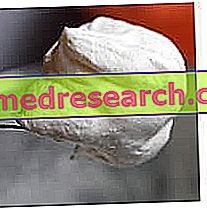Generality
Cooking cream is a derivative of fat-rich milk. It represents one of the three types of "cream of milk" available on the market and, unlike the "fresh" one, has a decidedly greater shelf life.

Even the cream from the kitchen (like the others) is obtained by re-incorporating the fats (organized in globules) of the milk which tend to separate by spontaneous surfacing, by industrial centrifugation or following the processing of the whey.
The cream from the kitchen does NOT lend itself to being mounted (reduced whippeability ); this is mainly attributable to the typical industrial processing of the product, which determines the gelling of casein proteins around fat globules (which gives it a solid consistency); moreover, the lipid supply (about 20-25%) is much lower than the ideal portion (about 35%) to obtain a solid and stable frame.
The composition of the various types of cream depends essentially on the method of extraction from milk; this is true both for the water-soluble components (lactose, proteins, mineral salts and water-soluble vitamins) and for the liposoluble components (triglycerides and fatty acids, some vitamins and cholesterol).
| TYPE OF CREAM | % fat |
| According to the Circular of the Ministry of Health (n.40 / 1974) | |
| Coffee cream | ≥ 10% |
| Cooking cream | ≥ 20% |
| Whipping cream or for pastry | ≥ 30% |
| Other types of Commercial Cream | |
| Double cream | ≥ 48% |
Also the microbiological quality varies according to the extraction technique; in particular, the density and types of microorganisms are higher in creams obtained by surfacing. It is also possible to state that the physical state of milk creams varies mainly on the basis of temperature. Cream glycerides are always liquids at + 40 ° C while they tend to crystallize around -18 ° C. The viscosity and stability of milk creams are therefore proportional to the degree of cooling.
Why doesn't the cream from cooking?
At this point, it is essential to explain why casein gelation occurs in the cooking cream and why, consequently, it does not lend itself to the frame.
As anticipated, cooking cream is a product aimed at long conservation. This result is obtained (always at an industrial level) through the UHT (Ultra Hight Temperature) process. This system is applied by treating the cream at very high temperatures for a few moments. As a result, food proteins (in particular caseins) modify their structure and recombine forming a water-soluble gel that traps fat globules.
Well, to whip the cream it is necessary to mechanically incorporate the air inside the food. allowing the protein to form a lattice then stabilized by fat globules. In cooking cream proteins (compromised by UHT) completely lose this capacity, without considering that the lipid fraction is in any case insufficient to stabilize the metamorphosis.
Some types of cooking cream contain emulsifiers (such as carrageenan) which also allow the addition of acids, alcohol, etc. to the product. without problems of lumps and phase separation (water separated from fat). Only after several months of preservation can one see a mild division of the liquid portion with respect to the solid portion.
Purpose of the cream - cooking cream in gastronomy
Cooking cream is an ingredient widely used in savory cuisine, while fresh cream also has an essential role in pastry (whipped cream). In addition to the trade in various milk creams, cream can be used to make butter.
Video Recipe - Find out how to make homemade butter from fresh cream
The cooking cream has a culinary role that is based on the presence of fats. These nutrients, depending on the type of recipe, participate in increasing the viscosity or softness of the preparations. In the structuring of an accompanying sauce (both for first courses and for second courses in pan), cooking cream participates in:
- Favor the creaminess of a liquid base and homogenize the consistency
- Increase succulence and palatability
- Correct any salting or spicing errors
- Harmonize the flavors
- Clarify the color
In the composition of a recipe based on flours (especially those to be leavened), cooking cream essentially contributes to:
- Promote softness
- Promote the preservation of softness even after dehydration (storage).
List of Video Recipes based on Cooking Cream
| Nutritional composition of cream or milk cream - Reference values of INRAN Food Composition Tables | ||||||||||||||||||||||||||||||||||||||||||||||||||||||||||||||||||||||||
 | ||||||||||||||||||||||||||||||||||||||||||||||||||||||||||||||||||||||||
Nutritional values (per 100 g of edible portion) | ||||||||||||||||||||||||||||||||||||||||||||||||||||||||||||||||||||||||
| ||||||||||||||||||||||||||||||||||||||||||||||||||||||||||||||||||||||||
In some cases (but not always), the cream can be replaced by milk. This arrangement can certainly favor the reduction of caloric intake and total cholesterol, as well as an increase in digestibility; however, milk proteins often tend to coagulate both due to the increase in temperature and to the presence of acid components.
Following this process, the accompanying sauces will be lumpy and tend to be "separated" (not emulsified).
WARNING! The frequent and ubiquitous use of cooking cream involves the standardization of the organoleptic and gustatory characteristics with relative assimilation of the various recipes.
Nutritional composition of cooking cream
Cooking cream is a highly energetic food because it is rich in triglycerides; moreover, among the fatty components, there is a noticeable intake of cholesterol and a ratio between fatty acids in favor of saturates (hypercholesterolemic lipids). The cream also provides a certain amount of protein and a more modest concentration of lactose.
From the saline point of view, the cream creates a mediocre concentration of calcium and phosphorus (as they are water-soluble, they are proportionally higher in milk and whey); as far as vitamins are concerned, being a product with a high fat content, liposoluble, in particular retinol equivalents (vit. A), stand out.
Kitchen cream is a product that does NOT lend itself to the diet of overweight individuals, those suffering from hypercholesterolemia and lactose intolerant. To be able to insert the cream into the diet it is necessary to reduce the dressing fats; however, this is a method of compensation that does NOT favor the presence of good fatty acids (unsaturated and / or essential) in the customary diet.



